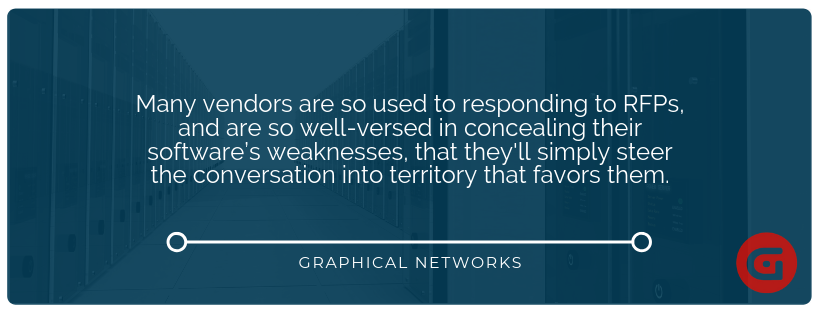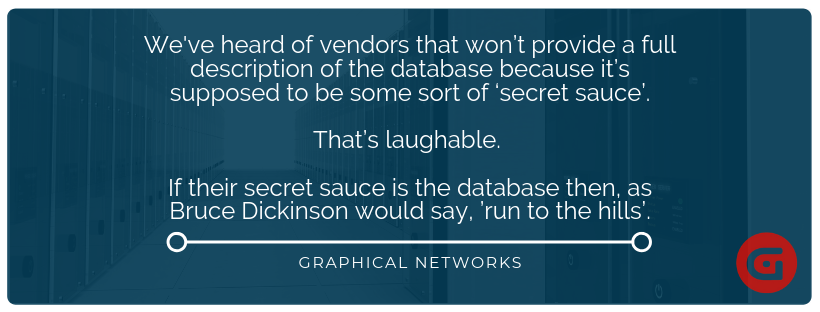
There’s a saying that goes, ‘the best marketer always wins’. And, if you think about it, this kinda makes sense. Why, exactly? Well…if you’re buying software such as data center infrastructure management software (DCIM), you typically don’t really get into the details of a software until after you’ve actually bought it.
If the best marketer always wins, you may be wondering where that leaves us (as the DCIM software vendor writing this article). As a financially stable and bootstrapped software company (with zero debt), we’ll just go ahead and say that in many cases the best marketer is the one with the deeper marketing budget.
As a consumer, how can you avoid the marketing razzle and dazzle when you’re first looking at a product — and evaluate if the DCIM software is actually good enough to fully meet your needs (now and in the future)?
Some time back, we wrote a series of blog articles (mostly vendor-agnostic) geared toward helping readers like you to choose the right DCIM software for your needs (you can read it here on our blog or download the eBook version here). In thid blog series, we go over the different steps that can help you make an informed decision about purchasing DCIM software, such as: narrowing down vendors, identifying the features you need, testing, writing a request for proposal (RFP), and preparing a proof-of-concept.
Though in our blog series we discuss the DCIM selection process in great detail, you won’t always have the luxury of taking a great deal of time to find DCIM (or you may simply not even want to go through the process of issuing a RFP — and we really can’t blame you).
Afterall, RFPs can be flawed: even if you do write an RFP, that doesn’t guarantee you’ll get meaningful answers to your questions. The truth is that many vendors are so used to responding to RFPs, and are so well-versed in concealing their software’s weaknesses, that they simply steer the conversation into territory that favors them.
There’s more to evaluating a DCIM solution beyond just the RFP and proof-of-concept steps (which you may or may not take): you need to look into performance and other indicators of quality that go beyond features.
Examples of questions you should ask a DCIM vendor include:
- How robust is the API?
- How well does it perform under heavy load?
- How secure is it?
Just as clear writing sometimes (or usually) implies clear thinking, there are certain things you can look into to unmask the real quality of a data center infrastructure management solution (in other words, there are litmus tests to which you can subject a potential DCIM solution).
So, if you are ready to look beyond the marketing tactics and under the hood of DCIM software, below are a few tips that may be helpful in evaluating a tool’s true quality:
Ask for documentation
When you ask us for documentation, we may ask you how big your loading dock is.
Why?
We’re not selling toys — we’re selling enterprise-grade data center infrastructure management software and we have a ton of documentation (we also just want to know if you are really going to read it — grin).
Regardless of whether you will actually read it all or not, it is a good practice to request documentation from the DCIM vendor. The reason is simple: software vendors that have their act together have the time to create proper and clear documentation.
The documentation you receive should go beyond just the basic DCIM functionalities. You should be able to request the following user guides:
- Admin Documentation
- Power user Documentation
- API documentation
- Specifications about integrations
Check out the user guides a vendor provides…and look at how well they are written. Explore how deeply they go into the functions and features — and how well they are formatted. While I know this may seem like an unimportant task, I can’t underscore this enough: it is a simple exercise that ultimately correlates clear thinking and organized engineering to the quality of the software itself.
And finally, here’s the kicker: ask for a full description of the database. That’s right: the DCIM vendor should be able to give you that. Now, a warning: we’ve heard of vendors that won’t provide this because it’s supposed to be some sort of ‘secret sauce’. That’s laughable. If their secret sauce is the database then, as Bruce Dickinson would say, ’run to the hills’.
Test for performance
Truth be told, a presentation, or a demo, or an RFP do not really tell you how well a DCIM software performs. However. there are certain tricks that you can use to find out if the software sings…
You can ask to test the software yourself in one of your servers. Installing netTerrain is simple, and we have done this many times, but certain vendors may not offer that option before you purchase a software. If this is the case, make them run a demo that has thousands of devices and then ask them to go and check the specifications of the server.
Why?
A properly designed DCIM software will perform under heavy load. Bad performance correlates — plain and simple — to bad software engineering (and that’s what you need to avoid).
API and integrations
This one area can be very interesting…and it can also get hairy very quickly. One of the key aspects of a good DCIM software is its ability to hook into external systems, to discover the network, and to tap into other data sources. How easily you can integrate is crucial.
Now, any vendor can claim their software can integrate…if they have an infinite amount of resources and time to do that, of course. The real question to ask is not if a DCIM software can integrate, but can it be done within a reasonable amount of time. More importantly: can you do it yourself as the user?
To test a DCIM tool’s integrations capacity, you can:
- Give the vendor a simple data source to integrate
- Look in to the API documentation, and see if it implements most of the things that you can do through the graphical user interface
- Ask which pre-defined connectors exist
- Ask which protocols are supported for discovery and what can be discovered
Summary
In conclusion, as a prospective customer, how can you really make sure that, when choosing a solution from amongst several DCIM vendors, the cream rises to the top?
Do your homework.
Read our blog series on how to choose DCIM software (or you can download the eBook version here), but also go over the documentation, explore the API and integration capabilities, and take a deeper dive.


